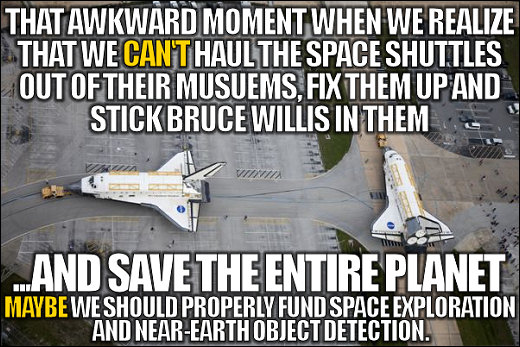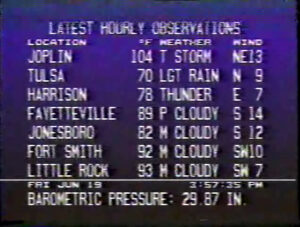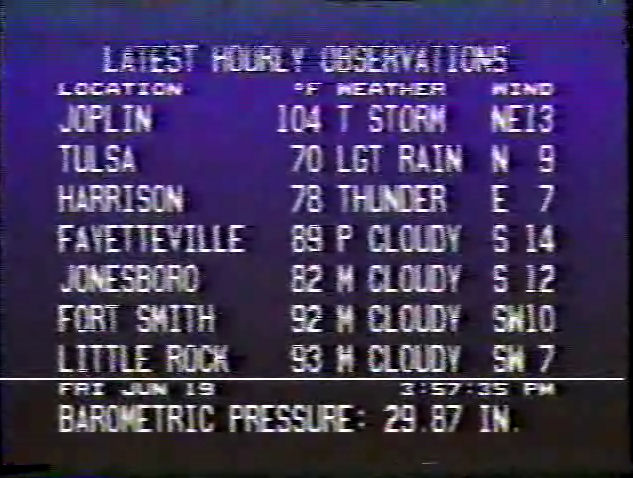So apparently, while we’re all waiting for asteroid 2012 DA14 to zip by in 12 hours or so, a decent-sized meteor we didn’t expect or detect almost made it to the ground in one piece in Russia.
This post is pretty Youtube-heavy.
Check out the sonic boom and the resulting exploding-window-glass problem from the ground view:
So, with all that in mind…
This should be a wake-up call about funding the space program (both manned and unmanned) and funding Near Earth Object (NEO) search/detection programs. This was a lucky near-miss – I’m not sure we want to find out what a less lucky near-miss (let’s say, for the sake of argument, Tunguska) would do to a populated area like this.
Or, as I tweeted in the wee hours of this morning:

Just a little something to think about. Priorities. One of these, big enough to make it to the ground and hitting in a heavily populated area, would make a lot of the other political infighting with which we tie ourselves up meaningless in – literally – a flash.




The reaction by the press (especially Fox) is full of fail and hilarity. Check out this video: https://video.foxnews.com/v/2166556494001/massive-meteor-rocks-russia-injuring-hundreds?intcmp=related?playlist_id=1821663211001
I love it when attractive news commentators talk about stuff they don’t know anything about. Like when one woman says it’s an Asteroid before it hits the atmosphere and then it’s a meteor. Um, no, it’s a meteoroid first. The hilarity ensues when she talks about NASA having ways to stop asteroids from hitting the Earth and one guy shouts “with lasers?” Ha! that was a face palm moment right there.
On a more serious not it looks like a bunch of people were injured by this meteor: https://www.foxnews.com/science/2013/02/15/injuries-reported-after-meteorite-falls-in-russia-ural-mountains/
Apologies – WordPress apparently held your comment for approval because of the links!
In watching Twitter and Facebook, speaking of facepalm moments, a disturbing degree of public science illiteracy became ominously apparent. And not just from people in this country. This wasn’t science fiction. This wasn’t some viral marketing event. This was a real wake-up call, and people think we actually have death rays to blast asteroids with, and we don’t. We’re pretty much defenseless. Had even this small event taken place over, say, Moscow, the damage resulting from it would’ve pushed this into “disaster” status. Folks need to wake up and smell the carbonaceous chondrites: this stuff doesn’t just happen over Russia, and there are assets threatened that aren’t even on the ground, and we often have little warning.
Science fiction is useful to visualize and contemplate what’s out there (which is the whole reason I’ve been working on the timeline), but where we are now, technologically, is a long way off from what’s in the movies. Maybe we need to properly fund space exploration and NEO detection/mitigation.
I think this small corner at the bottom of this infographic should be an eye-opener:
Not a terribly comfortingly large spread on size there.
NASA recently posted that they think the Russian Meteor was 55 feet in length and expended energy equivalent to a 300 Kiloton nuclear bomb (that’s more than 20 times the size of the Hiroshima bomb). Pretty impressive and makes you think the Russians got off easy with only broken glass and an occasional caved in roof. 1200 injured Russians is nothing compared to the casualties that might have happened if it took the meteor a little longer to break up and crashed in the middle of a city instead of a frozen lake.
NASA also estimates that the meteor was going 33,000 mph when it hit the atmosphere. With that in mind, I noted the time it took the meteor to cross the screen from a Russian dash-cam: 13 seconds. That comes to 119 miles which means the cloud left behind was at most 119 miles long. I’m sure it slowed some during those 13 seconds so maybe the cloud was only 60-80 miles long.